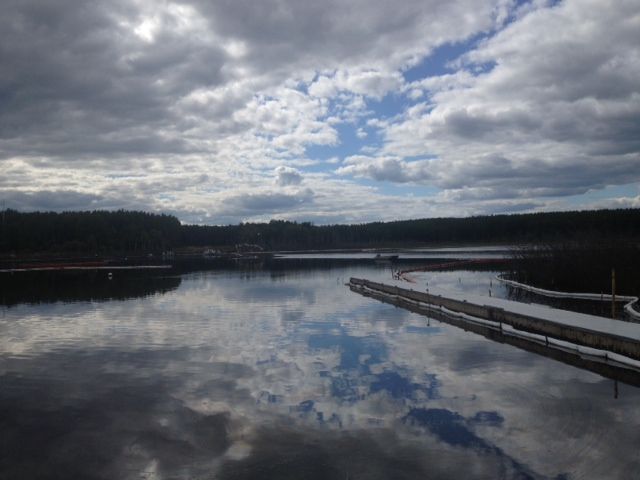A series of spills in northern Alberta is still oozing bitumen more than five months after the leaks began. And with no end in sight, Alberta’s Environment Ministry has taken what it says is an unprecedented step, asking Canadian Natural Resources Ltd. to partially drain an oil-soaked water body before it freezes this winter and traps a bitumen gash underneath it.

CNRL says the problem is mechanical failure from old boreholes underground. But the province took issue with that explanation after a similar spill at the same site in 2009.
Then, the provincial energy regulator suspected steam was being injected at too high a pressure for the rock formation to handle. It asked the company to halve the volume of steam it was injecting, and monitor the pressure on an ongoing basis.
“Geological weaknesses in combination with stresses induced by high-pressure steam injection may have contributed to the release, the regulator stated in an investigation report published earlier this year.
But Canadian Natural Resources Ltd. restarted operations well before that report was published. As of last spring, the Alberta Energy Regulator says, the energy giant’s Primrose operation at the Cold Lake Air Weapons Range was operating with “no specified limit” on the level of pressure it could use.
Then in May, a leak was discovered, followed by three more over the following weeks – all at various locations at its Primrose site.
Environmental activists worry these ongoing spills are caused by continued use of the same extraction method they say caused the last one.
This is where CNRL does high-pressure cyclical steam stimulation, shooting steam (as the name suggests) at high pressure into rock to loosen bitumen and let it rise to the surface. When there’s an uncontrolled spill, as there is now, it just keeps spilling until the pressure subsides.
The bitumen emulsion escaping from fissures in the rock hasn’t stopped in five months. As of Sept. 15, CNRL said, more than 1.2-million litres (about 10,300 barrels) had spilled, affecting about 7.4 hectares – down from 13.5 a couple of months ago.
About 2,000 litres continue to ooze out daily, the company says.

Get breaking National news
Environment Canada announced earlier this month it’s investigating the spill under wildlife laws. Multiple provincial agencies are looking into the spill’s causes and implications.
And this week, Alberta’s environment ministry asked CNRL to take two-thirds of the water out of the water body now steeped with seeping bitumen, out of concern the lake will freeze when winter sets in, even as oil continues to spill.
“We believe this is the first time we’ve required a portion of a waterbody to be dewatered,” Environment spokesperson Trevor Gemmell said in an email.
“The release will stop once the pressure that has been built up subsides. Unfortunately, we don’t have a timeline for when that will be. In the meantime, the environmentally responsible thing to do is to ensure containment measures are in place that will be effective no matter what the weather condition or season.”
(CNRL, for its part, says it “requested and received” the environmental order.)
Bitumen spills aren’t unusual in Alberta. Bitumen spills that last for months are.
“The ongoing nature of these releases separates them from traditional pipeline spills which are usually over in a matter of days,” Gemmell wrote.
“The last time a release of this kind occurred was in 2009 in Primrose East,” said energy regulator spokesperson Cara Tobin.
Watch: Tour CNRL’s Primrose spill site
CNRL says these spills are unrelated to the 2009 spill, and were all caused by old wellbores the company thought were properly sealed. “We are in the process of identifying and investigating these wellbores,” spokesperson Zoe Addington said in an email.
But some environmental activists question that conclusion.
“There’s no explanation being provided for why this is happening at four different sites, many tens of metres-long gashes in the earth that are just oozing oil,” said Chris Severson-Baker, managing director of the Pembina Institute . “It is disturbing. … What the company has said is happening, or their theory of what is happening, doesn’t at all make sense.”
The Alberta Energy Regulator says it doesn’t have enough information to say what caused the spill.
“We do not currently have the evidence or data to support any conclusions as to the cause of the incident and look forward to reviewing CNRL’s information supporting their conclusions on the root cause of the releases,” CEO Jim Ellis said in an Aug. 2 statement the regulator still cites when asked what it thinks went wrong.
The regulator was similarly skeptical of CNRL’s explanation for its 2009 spill. At the time, the regulator (then known as the Energy Resources Conservation Board) put limits on the volume of steam CNRL could inject and required the company to monitor pressure changes in the rock.
If the project as designed was shooting high-pressure steam the rock couldn’t handle, Severson-Baker argues, that could raise questions about the many other operations – in Alberta and elsewhere – that use high-pressure steam to extract resources.
“It appears very much that this project is fundamentally flawed in its design,” he said. “Something that’s completely not anticipated happens twice and in such a dramatic way … it raises doubts of the whole technology and the application of the technology.
“I think the whole credibility of the industry and government and the use of pressure to enhance extraction of oil and gas resources depends on a good track record for the oil and gas industry. And this is definitely not helping.”
Interactive: Spills at the Wolf Lake site.
Use the tabs at the top of the interactive to navigate.
Direct link to interactive
Interactive by Leslie Young








Comments